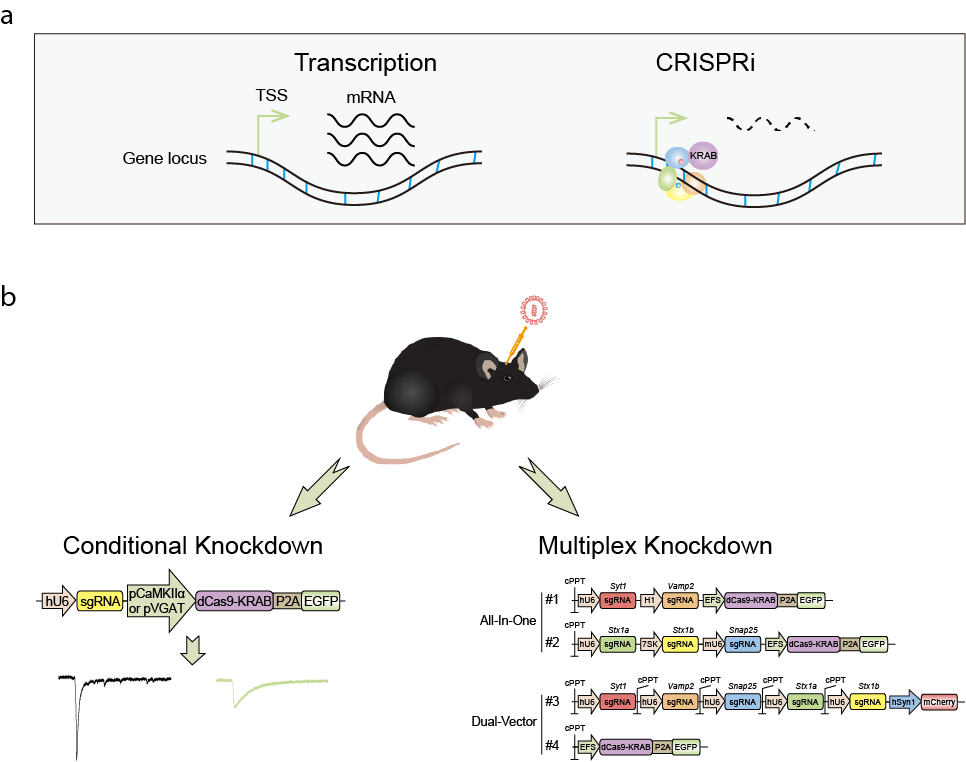On February 5th, 2018, the Yao lab’s new paper, entitled ‘CRISPR interference-based specific and efficient gene inactivation in the brain’, was published online in Nature Neuroscience. In this paper, Dr. Yao and colleagues reported their latest progress in establishing a dCas9/CRISPR-based gene silencing platform to achieve highly specific multiplex and conditional gene knockdown in the mammalian brain.
In recent years, by means of temporally precise optogenetic approaches to acutely manipulate neuronal activity, the functions of neuronal genes and neural circuits in various animal behaviors can be elegantly elucidated. Although the conditional recombination systems, such as Cre/LoxP and FLP/FRT, have been widely used to study the brain with spatiotemporal accuracy, it is often challenged by laborious and time-consuming animal model construction and unexpected animal developmental deficiencies. Hence, there is a need for neuronal genome regulating approaches that fall between the acute optogenetics and the conditional recombination systems to facilitate rapid gene function studies.
Cas9 nuclease has been widely used as a powerful genome editing tool to generate transgenic cell lines and animal strains. CRISPR/Cas9 has also been demonstrated to inactivate genes in postmitotic neurons. However, the mis-expressed truncated proteins that result from the random repair of cleavage sites may generate differential phenotypes in non-dividing neurons. Compared to the establishment of transgenic cell lines or animal strains, modifying genes in the neural network leads to greater challenges, especially due to the demand for the homogeneity of post-cleavage gene repair and the abolishment of deflected targeting. Recently, an engineered nuclease null form Cas9 (dCas9) has been developed into a versatile tool for gene regulation and imaging of genomic loci or mRNA. The dCas9-based CRISPRi approach, in which dCas9 is fused to the transcription repressor KRAB (dCas9-KRAB), has been developed to block transcription around a window of the transcriptional start site (TSS), yielding a promising gene knockdown (KD) technology. The avoidance of indels would improve the genotypic consistency following gene suppression, which would make CRISPRi particularly suitable for inactivating genes in the brain.
In this study, Dr. Yao’s group designed CRISPRi-based KD tools to inactivate a series of genes essential for neurotransmitter release in neurons. The authors found that CRISPRi can down-regulate the expression of all target genes to nearly complete abolishment. Furthermore, using the ChIP-qPCR analysis based on a pseudo-target fishing strategy, the authors demonstrated that CRISPRi had superior targeting specificity without detectable off-target activity in the neuronal application. The authors developed CRISPRi-based conditional gene KD tools to inactivate Syt1 in the dentate gyrus (DG) of the mouse hippocampus in a neuronal subtype-specific manner and achieved efficient bi-directional regulation of the excitation-inhibition (E-I) balance in this region. They found that the learning competency of the animals could be bi-directionally regulated; however, the mice always showed anxiety- and depression-like behaviors in response to the forward and reverse E-I adjustment. Therefore, the homeostasis of the E-I balance in the DG is essential for the coordination of cognitive behaviors. Finally, the authors developed two multiplex CRISPRi systems and demonstrated that multiplex CRISPRi was able to abolish five genes that encode a protein complex essential for neurotransmitter release in the brain. This study demonstrated that CRISPRi enables rapid and accurate gene function investigation in the brain.
Dr. Jun Yao from the School of Life Sciences and the McGovern Institute for Brain Research at Tsinghua University and Dr. Shuangli Mi from the Key Laboratory of Genomic and Precision Medicine, Beijing Institute of Genomics of the CAS, are co-corresponding authors of the paper. Two postdoctoral researchers from the Yao laboratory, Dr. Yi Zheng and Dr. Wei Shen, are co-first authors. All other co-authors made significant contributions to the paper.
Link to the paper: https://www.nature.com/articles/s41593-018-0077-5

Figure 1. Schematic showing multiplex and conditional CRISPRi in mouse brain.
